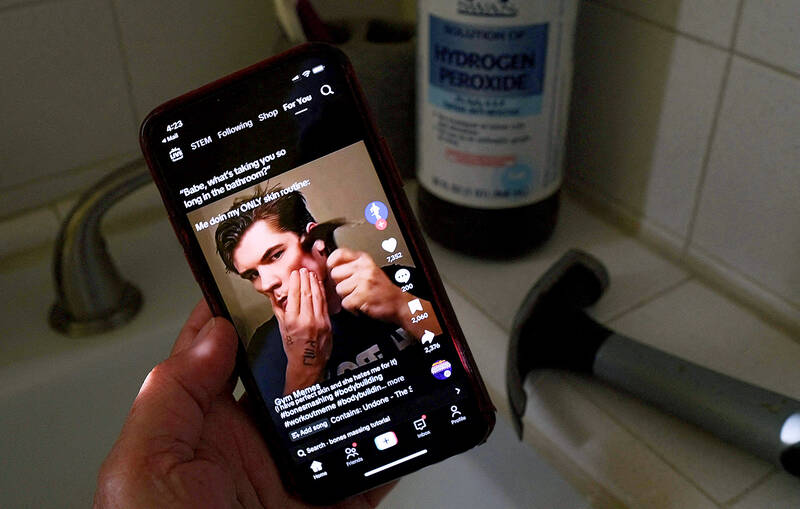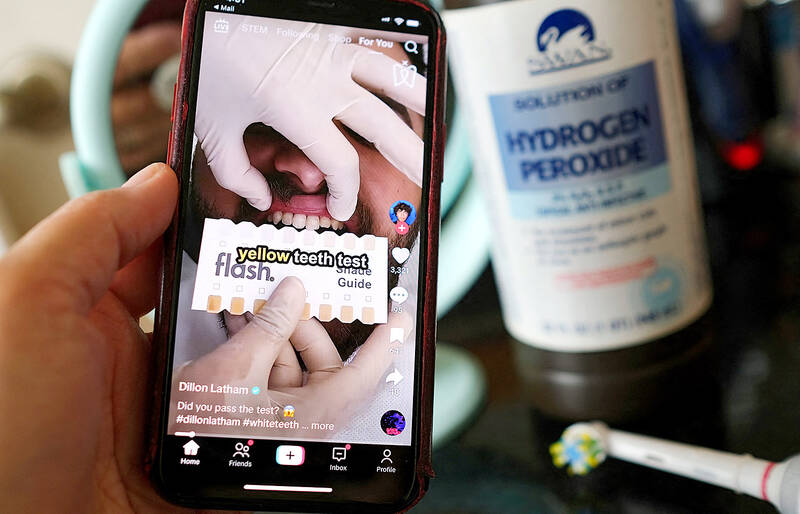0nkering for a chiseled jawline, a male TikTok influencer strikes his cheekbones with a hammer — highlighting the rise of “looksmaxxing,” an online trend pushing unproven and sometimes dangerous techniques to boost sexual appeal.
Looksmaxxing influencers — part of an online ecosystem dubbed the “manosphere” — have surged in popularity across social media, capitalizing on the insecurities of young men eager to boost their physical attractiveness to women.
In posts across TikTok, Instagram and YouTube, they promote pseudoscientific methods to achieve everything from pouty lips to chin extensions and almond-shaped “hunter eyes,” often while monetizing their popularity by endorsing a range of consumer products.

Photo: AFP
In more extreme cases, these influencers advocate taking steroids, undergoing plastic surgery and even “leg-lengthening” procedures to become more attractive.
While women may pay regular visits to aestheticians or buy new beauty products, spurring a global beauty retail market worth hundreds of billions of dollars, the manosphere at times promotes a DIY approach that draws on the nearest toolbox.
“Babe, what’s taking you so long in the bathroom?” reads the caption flashing across a viral TikTok video of a man seen hitting his cheeks with the sharp edge of a hammer, in what he calls his “skincare routine.”

Photo: AFP
Underneath the video are dozens of comments warning that “bone smashing,” also known as the hammer technique, was “dangerous” while others hailed it as a legitimate way to achieve an angular jawline.
In other videos, British influencer Oscar Patel promoted “mewing,” an unproven technique that involves pressing the tongue into the roof of the mouth for improving jaw and facial structure.
Without offering evidence, he told his nearly 188,000 TikTok followers that such tricks would turn them into a “PSL god,” an Internet slang for exceptionally attractive men, short for Perfectly Symmetrical Looks.
‘TOXIC COMINATION’
In another video, US-based TikToker Dillon Latham misleadingly told his 1.7 million followers to whiten their teeth by applying hydrogen peroxide to their teeth with a Q tip.
Some dentists warn that regularly using store-bought peroxide could damage tooth enamel and gums.
The looksmaxxing trend is fueling “an industry of influencers who promote ‘perfect bodies and perfect faces,’ often to feather their own nest,” said Siddharth Venkataramakrishnan, an analyst at the Institute for Strategic Dialogue.
“Among men, this is mixed with the misogyny of the manosphere, which often blames women for male insecurities, creating a toxic combination,” he added.
Many looksmaxxing influencers appear to have a financial incentive, frequently leveraging their popularity to promote products ranging from skin cleansers to pheromone perfumes, and even Chinese knock-off watches.
Looksmaxxing is rooted in “incel” — or involuntarily celibate — communities, an Internet subculture rife with misogyny, with men tending to blame women and feminism for their romantic failings.
“The incel ideology is being rebranded to looksmaxxing on TikTok,” said Anda Solea, a researcher at the School of Criminology and Criminal Justice at the University of Portsmouth.
In a study, Solea found that incel-inspired accounts on TikTok were circumventing a ban on hateful language with a focus on looksmaxxing and more palatable words about self-improvement.
“There are a lot of pressures on men — we want to protect women from gender-based violence but we should also be careful about young men and boys,” Solea said.
‘DEEPLY DAMAGING’
Other related maxxing trends have also gained traction, including “gymmaxxing,” which focuses on building muscle, and “moneymaxxing,” which centers on improving financial status — all with the ultimate goal of increasing sexual desirability.
Looksmaxxing influencers — many of whom idolize male models such as Australian Jordan Barrett and American Sean O’Pry — have amassed massive followings as algorithms propel their content to millions.
These algorithms can lead to real-world harm, experts warn. The danger was dramatized in the recent Netflix hit Adolescence, which follows the case of a 13-year-old boy accused of killing a classmate after consuming misogynistic content online.
The fictional crime drama references the popular but unfounded “80/20” theory that claims 80 percent of women are attracted to 20 percent of men.
In a study last year, researchers at Dublin City University created fake accounts registered as teenage boys. They reported that their TikTok and YouTube feeds were “bombarded” with male supremacy and misogynistic content.
“More widely, this does feed into toxic beauty standards which affect men as well as women,” said Venkataramakrishnan, from the Institute for Strategic Dialogue.
“The idea that if you don’t look like a Hollywood star, you might as well give up trying for a relationship is deeply damaging.”

May 11 to May 18 The original Taichung Railway Station was long thought to have been completely razed. Opening on May 15, 1905, the one-story wooden structure soon outgrew its purpose and was replaced in 1917 by a grandiose, Western-style station. During construction on the third-generation station in 2017, workers discovered the service pit for the original station’s locomotive depot. A year later, a small wooden building on site was determined by historians to be the first stationmaster’s office, built around 1908. With these findings, the Taichung Railway Station Cultural Park now boasts that it has

Wooden houses wedged between concrete, crumbling brick facades with roofs gaping to the sky, and tiled art deco buildings down narrow alleyways: Taichung Central District’s (中區) aging architecture reveals both the allure and reality of the old downtown. From Indigenous settlement to capital under Qing Dynasty rule through to Japanese colonization, Taichung’s Central District holds a long and layered history. The bygone beauty of its streets once earned it the nickname “Little Kyoto.” Since the late eighties, however, the shifting of economic and government centers westward signaled a gradual decline in the area’s evolving fortunes. With the regeneration of the once

The latest Formosa poll released at the end of last month shows confidence in President William Lai (賴清德) plunged 8.1 percent, while satisfaction with the Lai administration fared worse with a drop of 8.5 percent. Those lacking confidence in Lai jumped by 6 percent and dissatisfaction in his administration spiked up 6.7 percent. Confidence in Lai is still strong at 48.6 percent, compared to 43 percent lacking confidence — but this is his worst result overall since he took office. For the first time, dissatisfaction with his administration surpassed satisfaction, 47.3 to 47.1 percent. Though statistically a tie, for most

In February of this year the Taipei Times reported on the visit of Lienchiang County Commissioner Wang Chung-ming (王忠銘) of the Chinese Nationalist Party (KMT) and a delegation to a lantern festival in Fuzhou’s Mawei District in Fujian Province. “Today, Mawei and Matsu jointly marked the lantern festival,” Wang was quoted as saying, adding that both sides “being of one people,” is a cause for joy. Wang was passing around a common claim of officials of the People’s Republic of China (PRC) and the PRC’s allies and supporters in Taiwan — KMT and the Taiwan People’s Party — and elsewhere: Taiwan and